This past year, I made it my crusade to cut way back on plastic in our home, starting in the kitchen—where convenience had long disguised itself as necessity. I grew up in the swell of plastic: the microwave trays, the cling film, the bottled water. It was the language of modern living. But as evidence mounts on plastics and microplastics and their effect on human health, it’s impossible to ignore. Studies now link hormone-disrupting chemicals like BPA and phthalates to fertility issues, developmental disorders, and chronic disease. And even if the science is still evolving, the finding that the average person consumes the equivalent of a credit card’s worth of plastic each week is unforgettable.
In recent decades, plastic has become inseparable from the kitchen and grocery. Our stores are full of clamshell containers, shrink-wrapped produce, and shelves lined with plastic bottles—but it wasn’t always this way. Markets once relied on glass jars, paper wrapping, and aluminum. Plastic dominates today not because it’s essential, but because it’s subsidized—propped up by convenience, tax breaks, and a system built on disposability. That system, too, has entered the home kitchen over time.
The good news: Our kitchens are full of easy upgrades made from safe and durable materials—glass, cotton, stainless steel, and wood. It’s been the Remodelista ethos from the beginning: simplicity, longevity, and design built to last. Here are 10 considered swaps—beautiful, functional, and enduring—to help eliminate plastic from the place it matters most.
1. Plastic Wrap -> Beeswax or Plant-Wax Wraps
Quit your cling film habit and reach instead for beeswax or plant-wax wraps. They breathe, seal, and fully compost rather than slowly leaching chemicals into the food wrapped within. Research shows that thin plastic wraps—especially older PVC-based films—contain plasticizers like DEHA or phthalates that migrate into fatty foods (such as cheese, avocado, and oil-rich foods). Here, the heat and lipid content act as a solvent. By contrast, a well-made waxed cloth wrap provides a low-risk, protective layer that reduces oxidation and preserves flavor.
Above: Wax Atelier Linen Food Wraps are made of linen coated with natural beeswax, pine resin, and jojoba oil; $21 for the above set at Jam Jar. You can also find them at Nadi Noo in the UK for £22. This set from Cultures for Health is another solid-color option for $19.99.
2. Plastic Lunch Boxes -> Glass or Stainless Steel Containers
Recent lab studies have documented that microplastics and phthalates migrate from plastic containers into food—particularly under heat (for example, a bowl of warm grains), fat or ethanol content (avocados and fruits, for instance), or prolonged storage. Stainless steel lunch boxes and to-go containers are essentially passive: they won’t leach microplastics or additives and stand up to both temperature extremes and time.
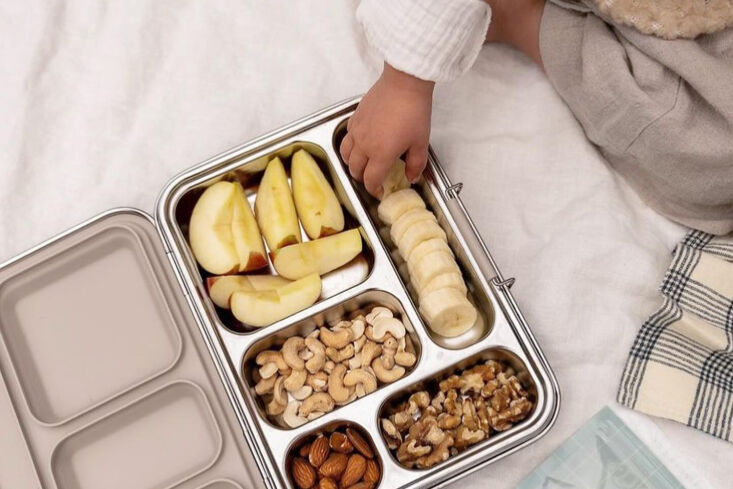 Above: This lunch box is from Danish brand Haps Nordic, suited for children but also adults. A similar option with defined sections is the Stainless Steel Ultimate Bento Box for $44.50 at Pottery Barn. For a more grown-up option, the Onyx Large 68-Ounce Bento Food Storage Container is $42 at Sustainable Haus Mercantile.
Above: This lunch box is from Danish brand Haps Nordic, suited for children but also adults. A similar option with defined sections is the Stainless Steel Ultimate Bento Box for $44.50 at Pottery Barn. For a more grown-up option, the Onyx Large 68-Ounce Bento Food Storage Container is $42 at Sustainable Haus Mercantile.
3. Plastic Produce Bags -> Fabric Produce and Bulk Bags
Bring an arsenal of cotton or linen produce and bulk bags for each grocery haul. This forward-thinking move eliminates that extra layer of single-use plastic and replaces it with something washable and built to last. Lightweight mesh cotton keeps greens relatively crisp, and tight-weave bags contain bulk grains and flour. You can then decant these into glass once home for refrigerator and pantry storage. A single set of bags can prevent hundreds of flimsy plastic bags from entering circulation each year.
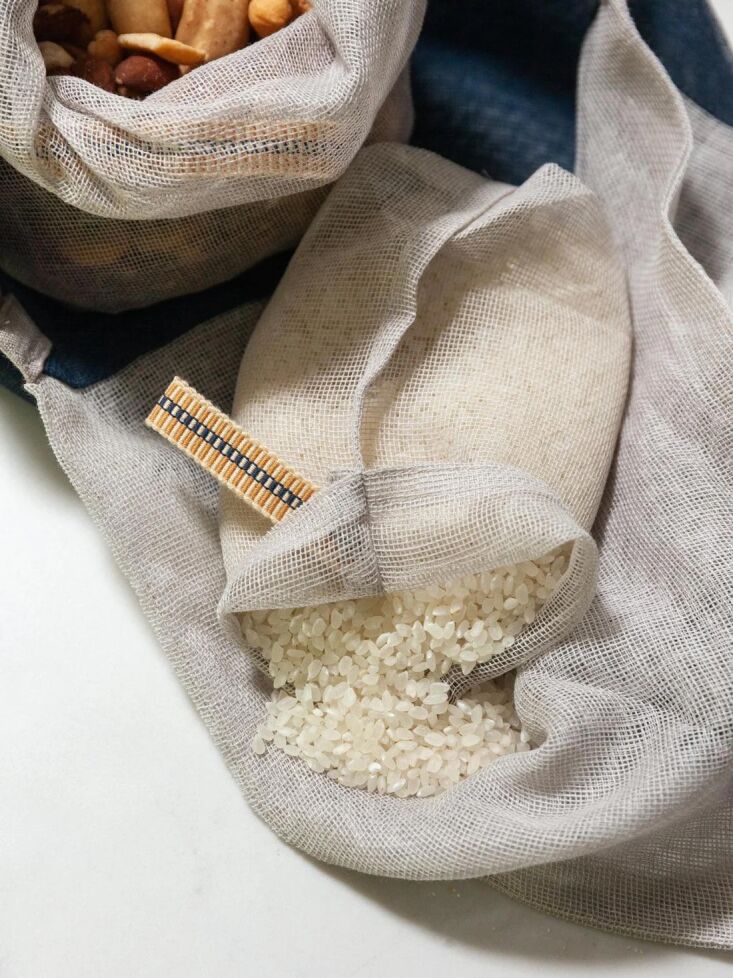 Above: We recently featured this set of cotton mesh sacks from Caya of Japan. The above is a Small Silver Caya Mesh Produce Bag for $7 at Rikumo. We also like the organic cotton sets available from EcoBags.
Above: We recently featured this set of cotton mesh sacks from Caya of Japan. The above is a Small Silver Caya Mesh Produce Bag for $7 at Rikumo. We also like the organic cotton sets available from EcoBags.
4. Plastic Refrigerator Bins -> Glass Jars and Containers
Trade cloudy plastic bins or restaurant-style tubs for clear glass jars and containers that bring both order and longevity to refrigerator storage. Glass creates an airtight seal that keeps food fresh without degrading or leaching microplastics when exposed to cold or moisture. Unlike plastic, glass won’t stain, warp, or turn cloudy over time—and studies show that even under low-temperature conditions, aging plastics can release microscopic particles.
 Above: Glass jars need not be brand new, as seen here in the pantry of an East Sussex kitchen (from Kitchen of the Week: An English Country Kitchen for a Vegan Family, Vegetable Processing Plant Included). Repurpose jars and containers or invest in a set of clear glass food storage containers such as the Trendglas JENA Centric Glass Dishes ($69.95 for a set of 3 at Boston General Store) or the Hold Everything Glass Food Storage Containers ($99.95 for a 14-piece set at Williams-Sonoma).
Above: Glass jars need not be brand new, as seen here in the pantry of an East Sussex kitchen (from Kitchen of the Week: An English Country Kitchen for a Vegan Family, Vegetable Processing Plant Included). Repurpose jars and containers or invest in a set of clear glass food storage containers such as the Trendglas JENA Centric Glass Dishes ($69.95 for a set of 3 at Boston General Store) or the Hold Everything Glass Food Storage Containers ($99.95 for a 14-piece set at Williams-Sonoma).
5. Plastic Utensils -> Wood, Metal, or Silicone Tools
Swap aging plastic tools for wood, stainless steel, or heat-safe silicone—materials that perform better and endure longer. Beyond their tactile and visual appeal, they’re also safer: as The Wall Street Journal recently reported, many black plastic utensils are actually made from recycled electronics and may contain flame-retardant chemicals that leach into food when heated. While the report focuses on black plastics, research shows that chemical migration can occur in many types of plastic utensils, especially when exposed to heat or acidity.
 Above: An example of wood and metal utensils in separate crocks from Julie’s kitchen (from Steal This Look: A Remodelista’s Minimalist Galley Kitchen in Brooklyn Heights).
Above: An example of wood and metal utensils in separate crocks from Julie’s kitchen (from Steal This Look: A Remodelista’s Minimalist Galley Kitchen in Brooklyn Heights).
6. Plastic Cutting Boards -> Wood or Paper Composite Boards
Plastic cutting boards dull knives and shed microplastics with each cut: a 2023 study found that polypropylene chopping boards released up to 79 million microplastic particles per year, and polyethylene boards released millions more. Swap them for end-grain butcher blocks, wooden cutting boards, or dense paper composite surfaces. These natural materials are safe, long-lasting, and resist staining with regular oiling and care.
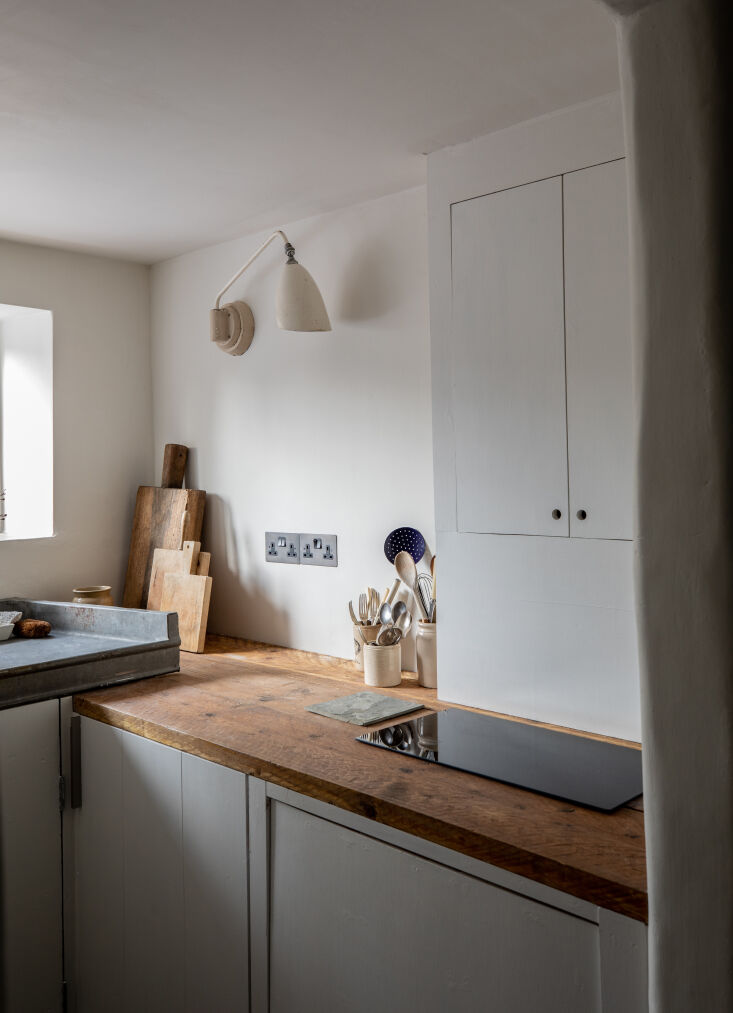 Above: A collection of well-cared-for wooden cutting boards from Kitchen of the Week: A Tiny Reclaimed Kitchen, Designed in a Wink.
Above: A collection of well-cared-for wooden cutting boards from Kitchen of the Week: A Tiny Reclaimed Kitchen, Designed in a Wink.
7. Plastic Dish Brushes and Sponges -> Natural Brushes and Cellulose Sponges
Retire plastic scrubbers and plastic-bristle brushes for cleaning tools made of coconut husk, sisal, tampico, and cellulose. These plant-based alternatives not only last but fully compost at the end of life—no hidden nylon fibers left behind. Synthetic sponges and bristles, on the other hand, shed microscopic plastic fragments with each rinse. The alternative—simple and biodegradable—keeps both the kitchen and waterways clean.
 Above: A sink in a Plain English kitchen features natural bristle brushes, cloths, and sponges. Photograph by Matthew Williams from Remodelista: A Manual for the Considered Home.
Above: A sink in a Plain English kitchen features natural bristle brushes, cloths, and sponges. Photograph by Matthew Williams from Remodelista: A Manual for the Considered Home.
8. Plastic Kettles and Coffee Makers -> Minimal Plastic or Glass Brewers
Choose kettles and brewers made with glass and stainless steel reservoirs and minimal plastic seals—the sort that reduce potential chemical leaching under heat. As we recently reported in our post 10 Easy Pieces: BPA-Free Coffee Makers, thin plastic components, especially those found in single-cup systems, can leach Bisphenol A (BPA) into hot water—up to 55 times faster than in room-temperature conditions. A glass pour-over, French press, stainless steel moka pot offers the cleanest caffeine extraction, and our list of coffee makers includes the lowest-plastic models available.
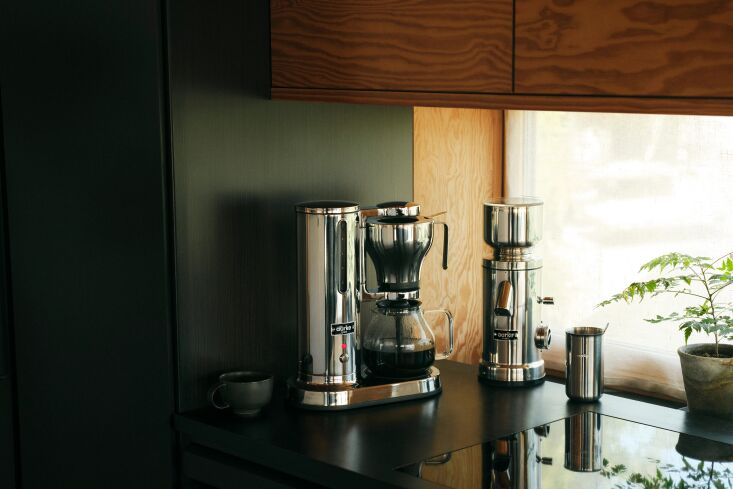 Above: Photograph from 10 Easy Pieces: BPA-Free Coffee Makers. For more options, see our post 10 Easy Pieces: Stovetop Espresso Makers.
Above: Photograph from 10 Easy Pieces: BPA-Free Coffee Makers. For more options, see our post 10 Easy Pieces: Stovetop Espresso Makers.
9. Plastic Water Bottles -> Refillable Metal or Glass Bottles
As The New York Times’ Wirecutter recently reported, bottled water often contains microscopic plastic fragments that slip through conventional filtration systems—even from so-called “clean” brands. A stainless steel or glass bottle, paired with an at-home filter (see our posts 10 Easy Pieces: Household Water Filters and 10 Easy Pieces: Reverse Osmosis Water Filtration Systems), offers a more evolved alternative—free of leaching and waste.
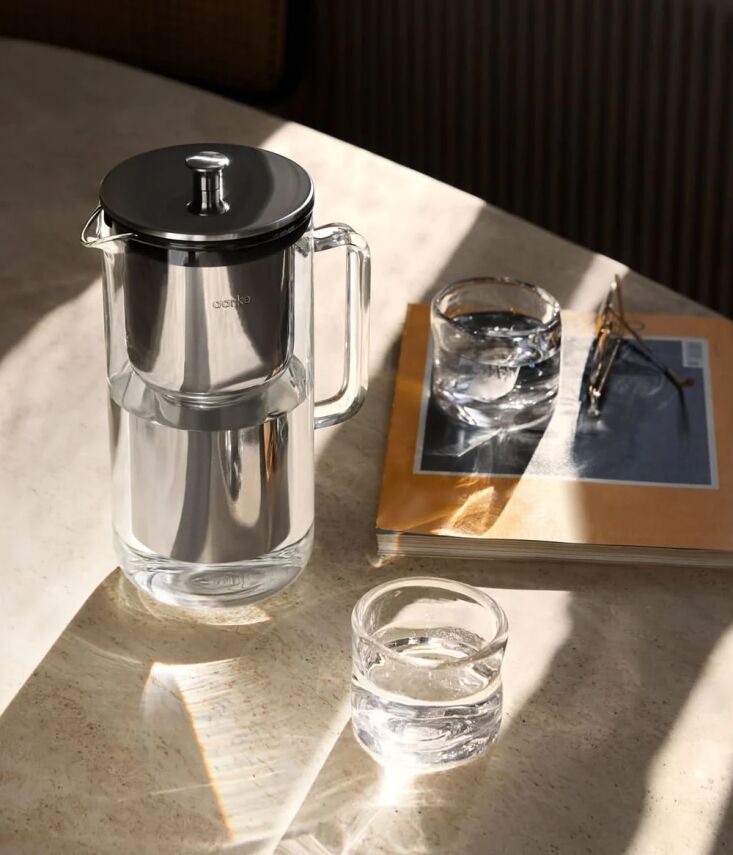 Above: Shown above is the glass Aarke Water Purifier Pitcher in the 5 cup size; $140 at Aarke.
Above: Shown above is the glass Aarke Water Purifier Pitcher in the 5 cup size; $140 at Aarke.
10. Plastic Ice Trays and Freezer Storage Bags -> Steel or Silicone Trays and Containers
Repeated freezing and thawing causes plastic trays, bags, and storage containers to contract and expand, releasing microscopic fragments into ice and food. Studies have found that both heat and cold accelerate microplastic shedding as polymers age and stiffen—particularly in polypropylene and polyethylene, the very same materials used in most freezer bins and bags. Stainless steel, aluminum, and food-grade silicone eliminate the concern of plastic taste and leaching with every freeze-and-thaw cycle.
 Above: HAY makes a simple, colorful Ice Cube Tray we like. Photograph from Hay Kitchen Market: Artful Essentials from a Copenhagen Design Duo. Another version is from Peak who make various sizes of ice cube trays; $16 at Sur la Table.
Above: HAY makes a simple, colorful Ice Cube Tray we like. Photograph from Hay Kitchen Market: Artful Essentials from a Copenhagen Design Duo. Another version is from Peak who make various sizes of ice cube trays; $16 at Sur la Table.
For more kitchen storage ideas, see our posts:



